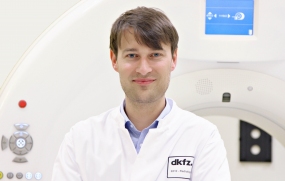21/09/2017
Print PageAmong the world’s best in radiology

Every year, radiologists worldwide eagerly await the results of the campaign that is conducted within the community to recognize the most influential medical imaging professionals of the year. The voting is published at the online forum "Aunt Minnie", an Internet radiology platform and resource that was founded in 1999. This year, Alexander Radbruch from the German Cancer Research Center (Deutsches Krebsforschungszentrum, DKFZ) in Heidelberg was voted among the top 15 candidates in the category Radiology Research.
In recent times, Radbruch and his group, which is affiliated both with the German Cancer Consortium (DKTK) at the DKFZ and the Neuroradiology Department of Heidelberg University Hospital, have gained recognition in the radiology community for their work on MRI contrast agents. Contrast agents that are based on the chemical element gadolinium are used in magnetic resonance imaging (MRI) to enhance the visualization of organs and tumors. They are considered safe and well-tolerated.
Since free gadolinium is toxic, the metal is bound to an organic molecule called a ligand for use as a contrast agent. There are two distinct categories of gadolinium-based contrast agents: In some products, the gadolinium ions are arranged in a linear structure in the ligand, while in others they are "caged" in a cyclic structure ("macrocyclic" agents).
In 2014, researchers from Japan were the first to report that following multiple agent-enhanced MR imaging examinations, gadolinium may deposit in the brain. Deposition was found primarily in specific brain regions, particularly in the dentate nucleus and globus pallidus.
Shortly afterwards, Radbruch found out than not all gadolinium-based agents are retained at the same levels in the brain. He discovered that the linear contrast agents lead to increases in signal intensities from gadolinium in the brain, while this effect has not been observed for macrocyclic agents.
"To date, there is no concrete evidence for any health problems associated with gadolinium deposition," Radbruch pointed out. "Gadolinium-based contrast agents help make life-saving diagnoses and are an indispensable tool in clinical routine. But it is obvious that if there is any doubt one should rather use substances that are not retained in the brain," said the radiologist.
MRI is an extremely common diagnosis method. Gadolinium-based contrast agents are used in about 40 percent of examinations. Approximately 400 million examinations with contrast agents have been performed worldwide. In Europe, the linear products have continued to be used in about 20 percent of cases until now. Worldwide, the share of this form of administration continues to be much higher.
As a consequence from the debate about gadolinium deposition in the brain, the European Medicines Agency (EMA) decided in July of this year that the risk-benefit ratio for linear gadolinium-based contrast agents can no longer be valued as positive and suspended approval for these agents (with the exception of imaging of the liver and the joints).
Alexander Radbruch studied Law and Medicine at the Universities of Heidelberg, Houston, and Munich. Since 2009, he has been working at Heidelberg University Hospital, Department of Neuroradiology. Since 2012, he has additionally led the Research Group "Neuro-oncologic Imaging" at the DKFZ and since 2014 he is part of DKTK. In collaboration with physicists at the DKFZ, he is already thinking ahead. The researchers have recently shown, for example, that a simple glucose solution can be used for imaging of tumors. "The future of imaging in oncology is sure to lie in the area of novel methods without contrast agents," Radbruch said. "But this still requires a lot of further research. Presently, it is unthinkable not to use gadolinium in clinical routine."
An image for this press release is available at: http://www.dkfz.de/de/presse/pressemitteilungen/2017/bilder/Radbruch.jpg
Note on use of images related to press releases
Use is free of charge. The German Cancer Research Center (Deutsches Krebsforschungszentrum, DKFZ) permits one-time use in the context of reporting about the topic covered in the press release. Images have to be cited as follows: "Source: Jutta Jung/DKFZ".
Distribution of images to third parties is not permitted unless prior consent has been obtained from DKFZ's Press Office (phone: ++49-(0)6221 42 2854, E-mail: presse@dkfz.de). Any commercial use is prohibited.
More information on the restrictions of gadolinium-based contrast agents:
https://www.krebsinformationsdienst.de/fachkreise/nachrichten/2017/fk21-ema-zu-gadolinium.php?campaign=kid/googlenews/fachkreise/nachrichten